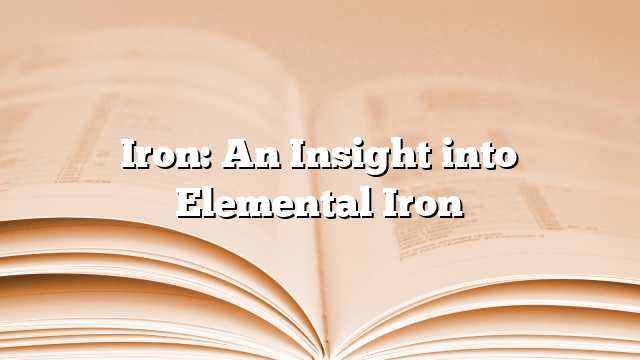Iron, also known as Fe in the periodic table, is a chemical element with atomic number 26. It is an abundant metal and one of the most widely used elements on Earth. Iron is classified as a transition metal and has been used by humans for thousands of years due to its unique properties and various applications in different industries.
Physical and Chemical Properties of Iron
Iron is a silvery-gray metal with a density of 7.87 grams per cubic centimeter. It is relatively soft and malleable, but it becomes significantly harder when mixed with small amounts of carbon, creating the alloy known as steel. Iron has a melting point of 1,538 degrees Celsius and a boiling point of 2,862 degrees Celsius.
In terms of its chemical properties, iron is highly reactive and readily forms compounds with other elements. It has a tendency to corrode in moist conditions, forming an iron oxide layer commonly known as rust. However, this corrosion can be prevented by applying protective coatings or using stainless steel, which contains a higher proportion of chromium.
Occurrence and Extraction of Iron
Iron is the fourth most abundant element in the Earth’s crust, making up approximately 5% of its total composition. It is mainly found in the form of iron oxides, such as hematite (Fe2O3) and magnetite (Fe3O4). These minerals are usually mined from the ground in large open-pit or underground mines.
The extraction of iron from its ores involves a series of steps. Firstly, the ore is crushed and concentrated to remove impurities. Then, it undergoes a process called smelting, where it is heated at high temperatures with a reducing agent, such as coke (a form of carbon). This process separates the iron from the oxygen, resulting in the production of molten iron known as pig iron.
Applications of Iron
Iron is a versatile metal with a wide range of applications across various industries:
-
Construction: Iron is commonly used in construction materials, such as beams, bars, and reinforcement rods due to its strength and durability.
-
Transportation: The automotive and aerospace industries heavily rely on iron and its alloys for the production of vehicles, aircraft, and engines.
-
Manufacturing: Iron is used in the manufacturing of machinery, tools, and equipment due to its high tensile strength and ability to be cast into complex shapes.
-
Energy production: Iron is used in the construction of wind turbines, generators, and transformers for efficient energy production and distribution.
-
Medical applications: Iron is essential for the production of hemoglobin in red blood cells, making it vital for oxygen transport in the human body. It is also used in the production of pharmaceuticals and dietary supplements.
Conclusion
Iron is a fundamental and versatile element that plays a crucial role in various aspects of our daily lives. From construction and transportation to energy production and healthcare, iron and its alloys have proven their value and significance in numerous industries. Understanding the physical and chemical properties of iron, as well as its extraction methods and applications, helps us appreciate the fundamental importance of this elemental metal in our modern society.




